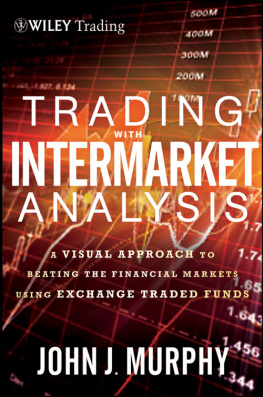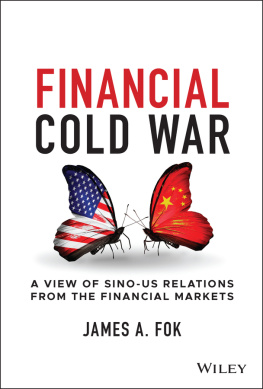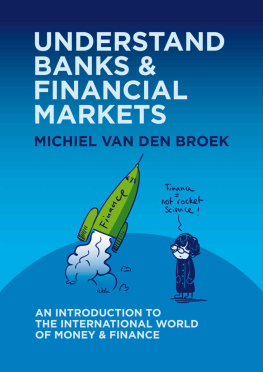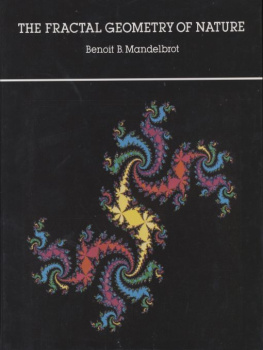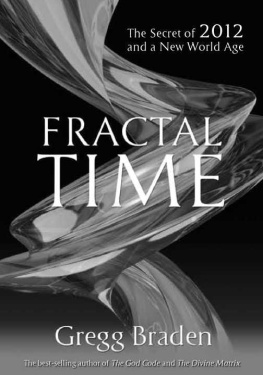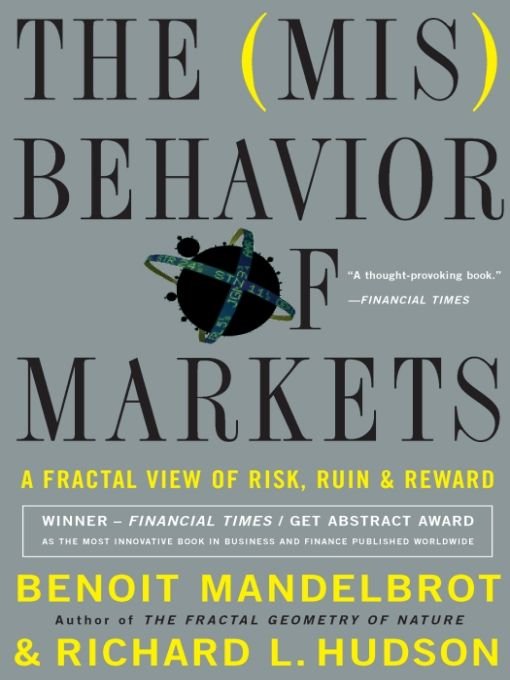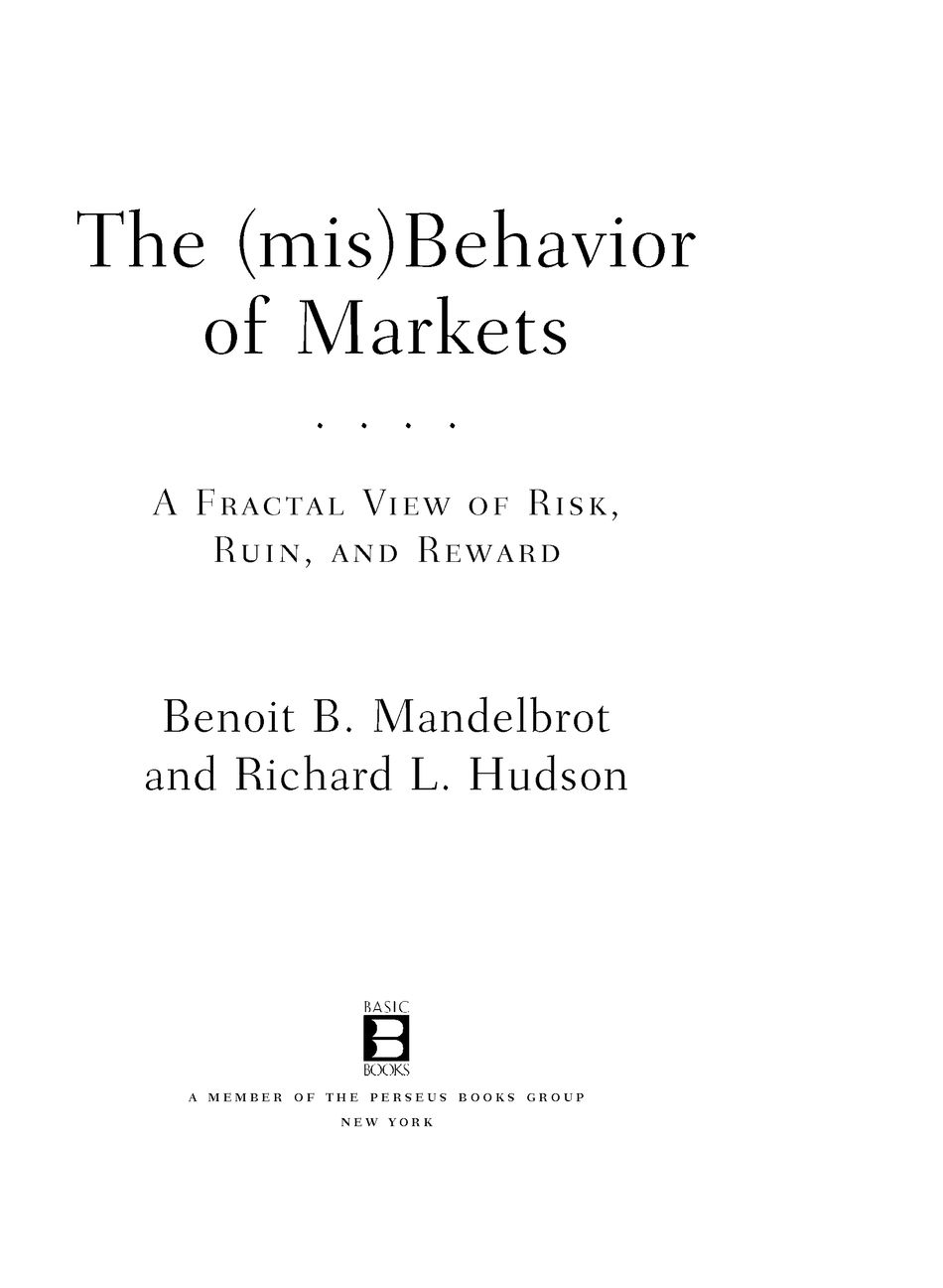Table of Contents
ALSO BY BENOIT B. MANDELBROT
Les objets fractals: forme, hasard et dimension
(1975, 1984, 1989, 1995)
Fractals: Form, Chance and Dimension
(1977)
The Fractal Geometry of Nature
(1982)
Fractals and Scaling in Finance:
Discontinuity, Concentration, Risk
(1997)
Fractales, hasard et finance (19591997)
(1997)
Multifracals and 1/f Noise: Wild Self-Affinity in Physics
(1999)
Gaussian Self-Affinity and Fractals:
Globality, the Earth, 1/f, and R/S
(2002)
Fractals, Graphics, and Mathematics Education
(With M. L. Frame)
(2002)
Fractals and Chaos:
The Mandelbrot Set and Beyond
(2004)
TO THE SCIENTIFIC READER: AN ABSTRACT
Three states of mattersolid, liquid, and gashave long been known. An analogous distinction between three states of randomnessmild, slow, and wildarises from the mathematics of fractal geometry. Conventional financial theory assumes that variation of prices can be modeled by random processes that, in effect, follow the simplest mild pattern, as if each uptick or downtick were determined by the toss of a coin. What fractals show, and this book describes, is that by that standard, real prices misbehave very badly. A more accurate, multifractal model of wild price variation paves the way for a new, more reliable type of financial theory.
Understanding fractally wild randomness, also exemplified by such diverse phenomena as turbulent flow, electrical flicker noise, and the track of a stock or bond price, will not bring personal wealth. But the fractal view of the market is alone in facing the high odds of catastrophic price changes. This book presents this view in a highly personal style, with many pictures and no mathematical formula in the main text.
Dedication
Aux Dames: Aliette, Diane, Louisa,
Clara et Ruth
Acknowledgments
NO BOOK IS MADE ALONE. In this instance the help and support of many people have been essential. Here they are acknowledged with gratitude.
Survival when taking high risks is often a reward for good timing. This is how Professor Mandelbrot repeatedly escaped ruin on his way to fractals. He is deeply in debt to the Thomas J. Watson Research Center of IBMfor thirty-five years a unique haven for mavericks engaged in investigations that science and society deemed desirable but had few ways of supporting. To list every helpful colleague would be impossible; but worthy of special mention is Ralph E. Gomory, to whom Mandelbrot was fortunate to report in various ways for much of his time at IBM. Upon retirement, Mandelbrot was brought to the Yale Mathematics Department by Ronald R. Coifman and Peter W. Jones, who opened to him another exceptional haven. Throughout, Aliette K. Mandelbrot provided extremely active participation, excellent advice, and unfailing enthusiasm.
For his part, Mr. Hudson would like to thank those who have encouraged his own small forays into risk, whether professional or personal. At Katholieke Universiteit Leuven, in Belgium, Dean Filip Abraham and Professor Paul De Grauwe of the Faculty of Economics and Applied Economics provided vital support and friendship with their offer for Mr. Hudson to work on this book as a visiting scholar in their midst. At the Wall Street Journal, Frederick S. Kempe encouraged this enterprise as both colleague and friend, and Paul E. Steiger and Karen Elliott House graciously granted leave to undertake it. And at home, Diane M. Fresquez was a guiding spirit. She helped review and research portions of the book; patiently transcribed many hours of tape-recorded discussions between the authors; and providedas everher generous encouragement and wise companionship.
For the art, we thank M. Gruskin, H. Kanzer, and M. Logan.
PRELUDE
by Richard L. Hudson
Introducing a
Maverick in Science
INDEPENDENCE IS A GREAT VIRTUE. To illustrate that, Benoit Mandelbrot relates how, during the German occupation of France in World War II, his father escaped death. One day, a band of Resistance fighters attacked the prison camp where he was being held. They disarmed the guards and told the inmates to flee before the main German force struck back. So the surprised and disoriented prisoners set off towards nearby Limoges, en masse and on the high road. After half a kilometer, Mandelbrot pre decided this way was folly. So he set off by himself. He left the main group and the open road and broke off into the thick forest to walk back home alone. Shortly after, he heard a German Stuka dive-bomber strafe the main party of prisoners on the high road. He, alone in the forest, escaped harm. It was, recalls the son, the way my father behaved throughout his life. He was an independent manand so am I.
Mandelbrot, a teenager during the war, is now famous. He got a Ph.D. in mathematical sciences in Paris, joined the influx of European scientists to America, and went on to a long career of scientific discovery and acclaim. He invented a new branch of mathematics, fractal geometry; he applied it to dozens of improbably diverse fields; and he received numerous awards and much media attention. But his early wartime lessons in independencehe says he was aguerri, or war-hardened, by his experiencesmade him always strike off in a direction different from the rest. He has thereby engendered much controversy, through which he persisted. He calls himself a maverick. By that, he means he has spent his life doing only what he felt right, sticking his nose where it was not always wanted, belonging to no particular scientific community.
I have been a lone rider so often and for so long, that Im not even bothered by it anymore, he says. Or, as a mathematically minded friend put it, he moves orthogonallyat right anglesto every fashion.
These facts about Mandelbrots life are important to remember when meeting him, as in this book. What he says is not what they normally teach at the business schools at Harvard, London, Fontainebleau, or his own university, Yale. He has been premature, contrary to fashion, trouble-making, in virtually every field he has touched: statistical physics, cosmology, meteorology, hydrology, geomorphology, anatomy, taxonomy, neurology, linguistics, information technology, computer graphics, and, of course, mathematics. In economics he is especially controversial. His first appearance in the field, in the early 1960s, caused a storm. Paul H. Cootner, then a well-known economist at MIT, praised Mandelbrots work as the most revolutionary development in the theory of speculative prices since the study began in 1900and then he went on to criticize details of its contents and Messianic tone. It has been like that ever since. The economics establishment knows him well, finds him intriguing, and has grudgingly adopted many of his ideas (though often without giving him full credit). That has made him one of the most important forces for change in the theory of finance. But the establishment also finds him bewildering.
So this book is an end-run, to a broader world and a broader audience than can be found in the faculty lounges of Cambridge, Massachusetts, or Cambridge, England. What Mandelbrot has to say is important and immediately relevant to every professional in finance, every investor in the market, anyone who just wants to understand how money gets won and lost with such frightening rapidity.


